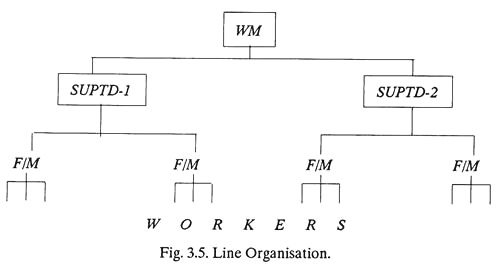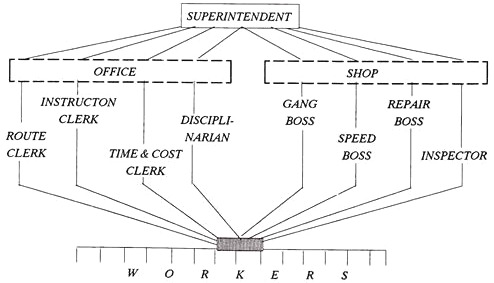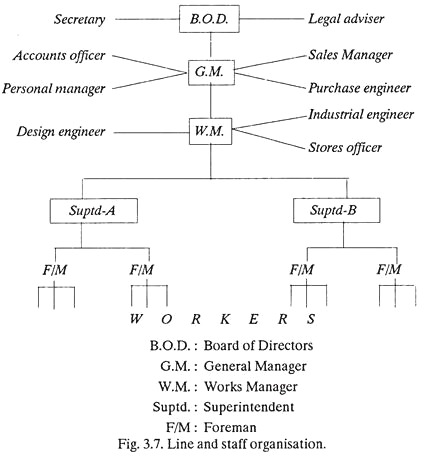A few commonly known forms of organisation structures or types of organisations are: 1. Line, Military or Scalar Organisation 2. Functional Organisation 3. Line and Staff Organisation.
Type # 1. Line, Military or Scalar Organisation:
It is the simplest form of organisation structure, (Fig. 3.5).
It was called military organisation because it resembled to olden military organisations. Line organisation is based upon relative authority and responsibility rather than on the nature and kind of operation or activities. The authority flows directly from the Works Manager (WM) to Superintendent to Foremen (F/M) and from them to workers.
ADVERTISEMENTS:
Line organisation is direct and people at different levels know to whom they are accountable. The immediate superior (or boss) gives orders to the subordinates, assigns duties, dismisses and takes disciplinary action against them. Any enterprise that starts small probably starts with a line type of organisation.
Advantages:
(i) It is simple and easy to understand.
(ii) It is flexible: easy to expand and contract.
ADVERTISEMENTS:
(iii) It makes clear division of authority.
(iv) There is clear channel of communication, with no confusion at all.
(v) It encourages speedy action.
(vi) It is strong in discipline as it fixes responsibility on an individual.
ADVERTISEMENTS:
(vii) It is capable of developing the all-round executive at the higher levels of authority.
Disadvantages:
(i) It neglects specialists.
(ii) It overloads a few key executives.
ADVERTISEMENTS:
(iii) It requires a high type of supervisory personnel to meet the challenges imposed in the absence of specialists as advisors.
(iv) It is limited to very small concerns.
(v) It encourages dictatorial way of working.
(vi) In line organisations provisions are seldom made to train, develop and replace top executives.
ADVERTISEMENTS:
(vii) Due to lack of specialisation perhaps there is more wastage of materials and manhours.
Applications:
Line organisation is suitable for:
(i) Small concerns free from all complexities; and
ADVERTISEMENTS:
(ii) Automatic and continuous process industries such as paper, sugar, textile, etc.
Type # 2. Functional Organisation (Fig. 3.6):
Fig. 3.6. Taylor’s functional organisation.
F. W. Taylor suggested functional organisation because it was difficult to find all-round persons qualified to work at middle management levels in the line organisation. Functional organisation is also a line type of organisation with the difference that instead of one foreman (which being master or specialist of everything and therefore hard to find) there are eight functional foremen; four of them located on the shop floor and remaining four in the office, but everyone having direct and equal authority over the workers.
ADVERTISEMENTS:
Each functional foreman who is a specialist in an activity is in charge of one function, e.g.:
1. Route clerk or order of work and route clerk was incharge of issuing work orders and routing the jobs.
2. Instruction clerk would issue specifications and instructions related to jobs to the workers.
3. Time and cost clerk keeps records pertaining to the time (the workers have spent in doing work) and cost (i.e., worker’s wages etc.)
4. Disciplinarian keeps personal records of the workers and handles cases of insubordination.
5. Gang boss has the charge of the preparation of all work up to the time that the work piece is set in the machine.
ADVERTISEMENTS:
6. Speed boss ensures that proper cutting tools are being used, cut is started at right place in the work piece, and the optimum speeds, feeds and depths of cut are being employed.
7. Repair boss is responsible for adequate repairs and maintenance of equipment and machinery.
8. Inspector or Inspection boss looks after and is responsible for the quality of the product.
Advantages of Functional Organisation:
1. Since a foreman is responsible for one function, he can perform his duties in a better manner.
2. Functional organisation makes use of specialists to give expert advice to workers.
ADVERTISEMENTS:
3. It relieves line executives of routine, specialised decisions.
4. Expert guidance reduces the number of accidents and wastage of materials, man and machine hours.
5. It relieves pressure of need to search a large number of all-round executives.
6. Quality of work is improved.
Disadvantages:
1. Coordination of the efforts of various functional foremen is difficult.
ADVERTISEMENTS:
2. It is difficult to maintain discipline as each worker is responsible to eight foremen.
3. It is very difficult to fix up the responsibility to any one foreman in case something goes wrong.
4. Workers always remain confused about the authority and activity of each foreman.
5. It makes industrial relationships more complex.
6. Workers are not given opportunity to make use of their ingenuity, initiative and drive.
7. All-round executives cannot be developed.
ADVERTISEMENTS:
Applications:
For these reasons (disadvantages), the functional organisation as such is obsolete; however in the modified form, employing the principles explained above, it is frequently used in some most modern and advanced concerns.
Type # 3. Line and Staff Organisation:
The line organisation gradually developed to shape as the line and staff organisation; Taylor’s functional organisation hastened its development. As the industry grew in size and complexity, the line executives could not perform properly all other functions (besides looking after production) such as R & D, planning, distribution, legal, public relations, etc. This necessitated the employing of special executives to assist line executives and they were known as staff as they were recruited to perform staff or specialist functions.
The line executives retain supervisory authority and control over the work of their subordinates whereas the staff executives relieve line executives of certain specialised work and advise them on matters referred to them. The final decision whether to accept and implement the recommendations of the staff executive remain in the hands of the line executive. Fig. 3.7 shows a line and staff organisation. The line executives are marked vertically whereas staff executives are placed horizontally.
A variation of line and staff organisation is Line and Functional Organisation in which the staff or specialist executive has full authority (i.e., a higher degree of authority than in a line and staff organisation) over his particular function which may be inspection, work study, purchasing, employment, etc.
ADVERTISEMENTS:
Advantages of Line and Staff Organisation:
1. Expert advice from specialist staff executives can be made use of.
2. Line executives are relieved of some of their loads and are thus able to devote more attention towards production.
3. Less wastage of material, man and machine hours.
4. Quality of product is improved.
5. There is no confusion as exists in functional organisation.
6. Line and staff organisation possesses practically all the advantages of both the line and functional organisations.
Disadvantages:
1. Product cost will increase because of high salaries of staff executives.
2. At times the staff department may infringe upon the rights and responsibilities of the line organisation, thus weakening the line organisation when its (i.e., staff department’s) true function is to strengthen this organisation.
3. Line and staff organisation may get confusion in case functions are not clear.
4. Frictions and jealousies if developed between line and staff executives may cause harm to the enterprise.
5. Line executives if they start depending too much on staff executives may lose their initiative, drive and ingenuity.
Application:
Line and staff organisation is very common among the medium and larger enterprises.


